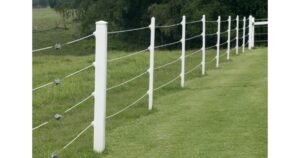If you’re a dog owner, you know how important it is to keep your furry friend safe and contained. One option for doing so is an electric fence. But can dogs get through electric fence? This question comes into every dog owner’s mind at the time of the decision to fence.
Electric fences have gained popularity over the period. They are one of the most effective ways to fence the dogs. Secondly, they are durable and can withstand all sorts of weather. In addition, they are cost-effective as compared to the Chain-linked and brick fencing systems.
In this article, we’ll explore what electric fences are, how they work, and the different types available for dogs. So let’s start!

What is an electric fence?
Table of Contents
ToggleAn electric fence is a type of dog fencing that uses a mild electric shock to deter dogs from crossing a designated boundary. The fence consists of a boundary wire that is buried underground or attached to a physical fence and a transmitter that sends a signal to the wire. When a dog approaches the boundary, the collar they wear receives a warning beep. If they continue to approach, they receive a mild electric shock.
Electric fences work by creating a psychological barrier for dogs. When a dog receives a shock from the fence, they learn to associate the boundary with the unpleasant sensation. Over time, the dog learns to avoid crossing the boundary, even when the collar is not on.
There are two main types of electric fences for dogs: wireless and in-ground. Wireless electric fences use a transmitter to create a circular boundary around the property. In-ground electric fences use a boundary wire that is buried underground or attached to a physical fence. Both types of fences can be customized to fit the size and shape of your property.
Can Dogs Get Through Electric Fence? Factors That Affect Electric Fence Effectiveness
While electric fences can be an effective way to contain dogs, there are several factors that can affect their effectiveness. These include the dog’s breed and size, temperament and behavior, training and socialization, and fence installation and maintenance.
Dog breed and size
Some dog breeds are more difficult to contain than others. For example, breeds that are bred for hunting or herding may be more likely to try to escape. Additionally, larger dogs may require a stronger shock to deter them from crossing the boundary.
Temperament and behavior
A dog’s temperament and behavior can also affect their response to an electric fence. Dogs that are easily frightened or anxious may be more reluctant to approach the boundary, while dogs that are more confident or aggressive may be more likely to challenge the fence.
Training and socialization
Proper training and socialization are key to ensuring that an electric fence works effectively. Dogs need to learn that the boundary is not to be crossed and that there are consequences for doing so. Additionally, dogs that are well-socialized are less likely to be distracted by other animals or people outside the fence.
Fence installation and maintenance
Finally, the installation and maintenance of the fence can also affect its effectiveness. The boundary wire needs to be buried at the correct depth and in the right location to ensure that the dog receives a consistent signal. Additionally, the collar needs to be properly fitted and maintained to ensure that it delivers the correct level of shock.
Can Dogs Get Through Electric Fences?
While electric fences can be effective, they are not foolproof. Some dogs may be able to get through or around the fence, depending on a variety of factors. Some dogs are able to get through electric fences, either by jumping over them, digging under them, or running through them. This is more likely to occur if the dog is highly motivated, such as when they are chasing a squirrel or trying to escape from a loud noise.
Factors that can make it easier for dogs to get through electric fences
Several factors can make it easier for dogs to get through electric fences. These include:
- Poorly installed or maintained fences
- Inconsistent or weak signals
- Collars that are not properly fitted or maintained
- Dogs that are highly motivated to escape
How to test if your dog can get through an electric fence
To test if your dog can get through an electric fence, you can try the following:
- Walk your dog around the perimeter of the fence, paying attention to their behavior and reactions.
- Try to entice your dog to cross the boundary, such as by throwing a ball or calling their name.
- Observe your dog’s response to the warning beep and shock.
If your dog is able to get through the fence, you may need to consider alternative containment systems.
Benefits of electric fences for dogs
The benefits of electric fences for dogs include:
- They are less expensive than traditional fences
- They are customizable to fit the size and shape of your property
- They do not obstruct views or landscaping
- They can be effective at containing dogs when used properly
Risks and potential dangers of electric fences for dogs
The risks and potential dangers of electric fences for dogs include:
- The risk of injury or death from the electric shock
- The risk of aggression or fear in dogs that are not properly trained or socialized
- The risk of escape if the fence is not installed or maintained properly
- The risk of interference from other animals or electronic devices
How to minimize risks and ensure your dog’s safety
To minimize risks and ensure your dog’s safety when using an electric fence, you should:
- Choose a high-quality fence system from a reputable manufacturer
- Install the fence according to the manufacturer’s instructions
- Train your dog to respect the fence and respond to the warning beep
- Monitor your dog’s behavior and safety when using the fence
- Consider using additional containment systems, such as traditional fences or GPS collars

Can Dogs Get Through Electric Fence? Alternatives to Electric Fences for Dogs
If you’re not comfortable using an electric fence for your dog, there are several alternatives available.
Traditional fences
Traditional fences are a popular option for dog owners. They come in a variety of materials and styles and can be customized to fit the size and shape of your property. However, they can be expensive and may obstruct views or landscaping.
Wireless dog fences
Wireless dog fences use a transmitter to create a circular boundary around the property. They are easy to install and can be customized to fit the size of your property. However, they may not be as effective as in-ground electric fences and can be more expensive.
GPS dog fences
GPS dog fences use a GPS signal to create a virtual boundary around the property. They are portable and can be used anywhere, but may not be as effective as other types of fences.
Factors to consider when choosing an electric fence for your dog
When choosing an electric fence for your dog, you should consider:
- The size and breed of your dog
- The size and shape of your property
- The quality and reputation of the manufacturer
- The cost and maintenance requirements of the fence
How to install and maintain an electric fence for dogs
To install and maintain an electric fence for dogs, you should:
- Follow the manufacturer’s instructions for installation and maintenance
- Test the fence regularly to ensure that it is working properly
- Replace batteries and collars as needed
- Keep the boundary wire clear of debris and vegetation
How to train your dog to respect the electric fence
To train your dog to respect the electric fence, you should:
- Introduce your dog to the fence gradually, using positive reinforcement
- Use a leash to guide your dog around the perimeter of the fence
- Allow your dog to experience the warning beep and shock in a controlled environment
- Reward your dog for staying within the boundary
How to monitor your dog’s behavior and safety when using an electric fence
To monitor your dog’s behavior and safety when using an electric fence, you should:
- Observe your dog’s behavior and reactions to the fence
- Check the collar regularly to ensure that it is properly fitted and functioning
- Monitor the boundary wire for damage or interference
- Consider using additional containment systems, such as traditional fences or GPS collars

Conclusion
Electric fences can be an effective way to contain dogs, but they are not foolproof. It’s important to understand how electric fences work, how dogs can get through them, and how to minimize risks and ensure your dog’s safety. By following the tips and guidelines outlined in this article, you can make an informed decision about whether an electric fence is right for your dog and how to use it properly.
FAQs
Can Dogs Get Through Electric Fence
Electric dog fences, also known as invisible fences, are a popular choice for pet owners looking to provide their dogs with a safe and contained outdoor space. These fences typically consist of a boundary wire buried underground or a wireless signal transmitted from a central unit, along with a special collar that emits a static correction when the dog approaches or crosses the established boundary. While electric fences can be effective for many dogs, the question of whether dogs can get through them depends on several factors.
- Dog Breed and Size: The breed and size of the dog play a significant role in determining whether they can get through an electric fence. Smaller dogs, in particular, may find it easier to squeeze through or dig under the fence compared to larger breeds.
- Training and Temperament: Proper training is essential for the success of an electric fence. Dogs must learn the boundaries and understand the consequences of crossing them. A well-trained dog is less likely to challenge the fence. Additionally, a dog’s temperament can influence their response to the static correction. Some dogs may be more sensitive, while others may be more determined to push through.
- Challenges for Determined Dogs: Determined or high-energy dogs may pose more of a challenge. They might learn to time their movements to avoid the static correction or become desensitized to it over time. These dogs may require additional training and supervision.
- Proper Installation and Maintenance: The effectiveness of an electric fence also depends on proper installation and maintenance. The boundary wire must be buried at the correct depth, and the collar should be correctly adjusted to ensure that the dog receives a consistent correction signal.
- Alternative Dog Containment Options: While electric fences can be effective for many dogs, they may not be suitable for all situations. Some alternatives include traditional physical fences, outdoor dog kennels, supervised playtime, or combining an electric fence with other containment methods.







